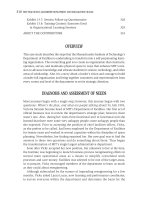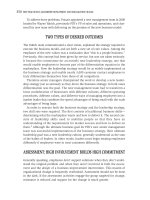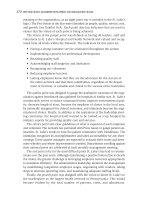Tài liệu Best Practives in Leadership Development & Organization Change 35 pdf
Bạn đang xem bản rút gọn của tài liệu. Xem và tải ngay bản đầy đủ của tài liệu tại đây (137.66 KB, 10 trang )
310
BEST PRACTICES IN LEADERSHIP DEVELOPMENT AND ORGANIZATION CHANGE
Exhibit 13.7: Session Follow-up Questionnaire 328
Exhibit 13.8: Training Content: Exercises Used
in Organizational Learning Sessions 329
ABOUT THE CONTRIBUTORS 333
OVERVIEW
This case study describes the steps that the Massachusetts Institute of Technology’s
Department of Facilities is undertaking to transform into a self-perpetuating learn-
ing organization. The overarching goal is to create an organization that constructs,
operates, serves, and maintains physical space in ways that enhance MIT’s mis-
sion to advance knowledge and educate students in science, technology, and other
areas of scholarship. Also it is a story about a leader’s vision and courage to build
a leader-full organization and bring together customers and representatives from
every corner and level of the department to set its strategic direction.
DIAGNOSIS AND ASSESSMENT OF NEEDS
Most journeys begin with a single step; however, this journey began with two
questions: Where’s the plan, and what are people talking about? In July 1993,
Victoria Sirianni became head of MIT’s Department of Facilities. Her first act of
official business was to review the department’s strategic plan; however, there
wasn’t one. Also, during her visits from functional unit to functional unit she
learned that there were some very unhappy people; more unhappy people than
she expected. Prior to accepting the position of chief facilities officer, Vicky,
as she prefers to be called, had been employed by the Department of Facilities
for twenty years and worked in several capacities within the discipline of space
planning. Nevertheless, her finding surprised her. Her new goal was to find the
answers to these two questions and do something about them. Thus began
the transformation of MIT’s single largest administrative department.
Soon after Vicky accepted her new position, but unknown to her at the time,
the Institute was beginning to launch business process reengineering efforts in
several main operational areas as a means to simplify convoluted work
processes and save money. Facilities was selected to be one of the target areas,
so to prepare, Vicky encouraged members of the department to learn as much
as they could about reengineering.
Although sidetracked by the rumors of impending reengineering for a few
months, Vicky asked Laura Lucas, now learning and performance coordinator,
to survey everyone within the department and determine the basis for the
cart_14399_ch13.qxd 10/19/04 1:15 PM Page 310
MIT
311
unhappiness. The questions were direct: How are we communicating internally,
do you feel that your ideas and suggestions are valued, and do you believe that
you and your coworkers perform to the highest standard of excellence? The
answers were just as direct: Our biggest problem presently is that [name
deleted]’s autocratic style has led to a breakdown of communications and mis-
trust between workers and line supervisors, there is nothing that could be said
to change this so it won’t matter, and everyone should do their fair share of the
work. Whether these responses were from people lashing out at their supervi-
sors and workmates or those reacting to the uncertainty of reengineering, it was
easy to conclude that something was wrong. Fortunately, there were many pos-
itive comments. For example: I’m proud to support a fine institution such as MIT,
I’m proud that it’s in the midst of real change and that we may be able to make
this a high-quality energized environment, and Facilities is a friendly place to
work.
Whether the problems were real or perceived they had to be addressed. To
this end, Vicky, Laura, and Joe Gifun, currently assistant director of Facilities
for infrastructure renewal and special projects, imagined that Facilities employ-
ees could take control of the future. Therefore, they pulled together a large num-
ber of people representing every aspect of the department, took the information
collected by the survey, combined it with information from other initiatives
already under way, and used it to write the department’s first strategic plan.
The word was sent out asking for people to come forward to participate
in writing the plan. Fifty volunteers were distributed into one of four focus
groups: communications; empowerment and accountability; leadership, man-
agement, and fairness; and recognition. Each team included a mix of unionized
service staff, administrators, architects, engineers, computer experts, adminis-
trative assistants, and maintenance, grounds, and custodial service supervisors.
The goal was to make each focus group as cross-functional as possible. Each
group was charged with analyzing the survey responses and determining the
strengths, weaknesses, opportunities, and challenges for the particular focus
area and to recommend concrete action items. All of the work was compiled
into one document and the strategic plan was published and distributed to all
members of the department in December 1994.
As one of the outcomes of the strategic plan was the desire and necessity for
more training, Facilities launched three departmentwide training efforts: com-
munications, teamwork, and diversity. Also, Facilities built a mechanism to
ensure linkage between learning and performance and worked with human
resources to determine competencies for each job classification. It was at this
stage that Laura restructured Facilities’ training department to focus on learning
and performance.
The Strategic Leadership Team (SLT) was formed soon after the creation of
the strategic plan and was a collective of several formal leaders but mostly
cart_14399_ch13.qxd 10/19/04 1:15 PM Page 311
312
BEST PRACTICES IN LEADERSHIP DEVELOPMENT AND ORGANIZATION CHANGE
informal leaders. The SLT comprised a diverse group of people from all walks
of department life and several customers who came together to express their
frustrations and ideas about current practices and the future of the Department
of Facilities. The SLT also acted as an advisor to Vicky and her directors and as
a sounding board for new ideas. Members of the SLT operated under two rules:
keep a departmentwide strategic focus and maintain the spirit of the original
strategic plan and its amendments.
There were fifty-six action items listed in the strategic plan, and much
progress has been made. Exhibit 13.1 shows the status of the fifty-six action
items in 1999 and again in 2002. Of particular interest is the action item that is
labeled “in progress”; it calls for the implementation of an external and inter-
nal communications program. Since 1994 several communications programs
and processes have been put into place. Although some have had a moderate
level of success, complete success has been elusive. Facilities has yet to deter-
mine the balance point between level of service (the information the inter-
nal and external customer needs and the form in which it is delivered or
presented) and cost. Facilities defines the internal customer as the Facilities
employee who functions as a customer when requesting services from another
team or functional unit, such as technical assistance on a project, training, and
building-system repairs. The external customer is any member of the MIT
community who is not a Facilities employee.
MAINTAINING THE SPIRIT AND SETTING THE TONE
People say that there needs to be full support “at the top” for successful growth
and change in any organization. MIT’s Department of Facilities was very lucky
to have a leader who was committed to making a difference within the depart-
ment and had the vision to put the appropriate pieces together to make that
happen. The department is a team-centered environment where people can
express ideas and work together at resolving issues, formulating policy, and,
yes, developing a strategic vision for the department. The department respects
independent thinking and believes in the reengineering concept of empowering
people to get the job done and done well. To do so, one needs to have the
appropriate tools, resources, and the ability to learn from mistakes.
Under Vicky’s leadership, the department began to use teamwork as a means
to discuss alternatives, make decisions, and resolve issues as they came up.
These teams worked both within and across established service areas—
operations, utilities, design and construction, capital projects, finance and
accounting, administration, systems engineering, and infrastructure—where
each service area is led by a director. From 1998 to summer 2002, three standing
teams supported Vicky, the directors, the operational leadership team, and the
cart_14399_ch13.qxd 10/19/04 1:15 PM Page 312
MIT
313
strategic leadership team. The operational leadership team has transformed over
time and consists now of functional unit managers; it provides a forum for the
managers to discuss operational issues that have an impact on all units and to
update each other on current and upcoming activities. The strategic leadership
team has transformed as well, and Vicky and the directors have adopted its
format, investigatory function, and team-based leadership model.
Over the course of time, Facilities employees experienced the value of teams
first-hand; therefore, individual teams would be formed for specific purposes
and in many cases without formal permission. These ad hoc teams, whether
official or unofficial, became a breeding ground for informal leaders and a tool
used by informal leaders to advance an idea. Informal leaders came from all pay
categories. They were supervisors, managers, unionized service staff, adminis-
trative assistants, support staff, and even directors. In many cases, teams have
made departmental decisions and developed and implemented major processes.
This practice created an environment of openness and enabled cross-functional
discussions to help individuals understand that most issues were important to
all, not just to an individual’s service area.
The Facilities division maintains an open environment that can constantly
refresh itself. Facilities employees understand change and the need to develop
a culture that reflects upon itself and continues to enhance the lives of its teams,
leaders, and individuals. Formal and informal teams exhibit much pride, engage
their members, and produce high-quality work. Teams are the place where
Facilities looks for emerging leaders.
INTERVENTION
Although some previous initiatives had failed and others lived out their useful
lives satisfying their intended purposes, one can readily observe that Facilities is
a very different organization now. Nevertheless, Facilities, like any organization
that desires to thrive in the marketplace, must provide its customers with higher
value than their competitors, in this case facility management and maintenance
firms. Facilities, like its competitors, must at the very least keep pace with the
changing technology in building systems, such as those that monitor and control
the interior climate of buildings and fulfill, at least minimally, the expectation
of the MIT community to provide more service and deliver it much faster than
it has ever been. So the need for learning continues but at a much higher devel-
opmental level. The current goal is to help Facilities employees become better
thinkers so that they will have the skills to create and sustain a self-perpetuating
learning organization. To achieve this goal, Facilities sought the help and expe-
rience of Dr. Carol Zulauf, a professor of organizational learning at Suffolk Uni-
versity. Dr. Zulauf, consulting partner, Pat Kennedy Graham, director of
administration, and Joe Gifun invested much time in frankly discussing all that
cart_14399_ch13.qxd 10/19/04 1:15 PM Page 313
314
BEST PRACTICES IN LEADERSHIP DEVELOPMENT AND ORGANIZATION CHANGE
has happened, good and bad, within the Department of Facilities over prior
years to ascertain its current strengths and weaknesses and recommend a course
of action to Vicky. The primary methodology used during the planning discus-
sions was guided brainstorming. Once ideas were recorded, they were clarified
if necessary and challenged. The result was to develop a series of learning mod-
ules introducing Peter Senge’s five disciplines. The first module was introduced
to the assistant directors and members of the operational leadership and strate-
gic leadership teams and focused on systems thinking. The second module, per-
sonal mastery, was offered to informal leaders, whether or not they were
members of a current team, and others who had shown the initiative to lead.
Highlights of these programs are presented as follows.
Program Design Stage
The strategic goals and priorities that were developed and introduced by the
operational leadership team encompassed the following:
• Improve customer service
• Enhance and protect MIT’s assets
• Design, build, and deliver on the capital projects
• Continuous improvement in core processes
• Meet MIT’s commitment to the environment
• Develop individual and organizational capabilities
Dr. Zulauf, working very closely with two of the key people from the Depart-
ment of Facilities, focused on two subsets within the “develop individual and
organizational capabilities” strategic goal: (1) develop, adopt, and implement
new HR practices and (2) renew learning and performance effort.
When the consulting partner first started to envision the interventions for
this project, using these strategic goals and priorities as her driving force, she
had as her overall framework the organizational and individual capabilities as
defined by the Balanced Scorecard, developed by Dave Ulrich and others in
Results-Based Leadership. This framework included, from the organizational per-
spective, considering the capabilities for learning and innovation, working
toward “boundary-less-ness,” or in the language of the Department of Facilities,
working cross-functionally, and building in accountability. The employee
perspective encompasses increasing performance by developing and leveraging
employee capabilities and intellectual capital. The results, over time, would
include new best practices within Facilities and a positive impact on Facilities’
internal and external customer base.
With the focus on developing organizational and employee capabilities as
the overall framework for designing the initial learning and performance
initiative, the consulting partner then took this overall framework to the level
cart_14399_ch13.qxd 10/19/04 1:15 PM Page 314









